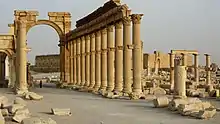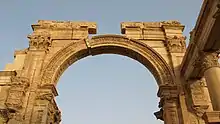Monumental Arch of Palmyra
The Monumental Arch, also called the Arch of Triumph (Arabic: قوس النصر) or the Arch of Septimius Severus, was an ornamental archway in Palmyra, Syria. It was built in the 3rd century during the reign of emperor Septimius Severus. Its ruins later became one of the main attractions of Palmyra until it was officially destroyed by the ISIS in 2015. Most of its stonework still survives and there are plans to rebuild it using anastylosis.
| Monumental Arch | |
|---|---|
قوس النصر | |
 Ruins of the Monumental Arch in 2010 | |
| Alternative names | Arch of Triumph Arch of Septimius Severus |
| General information | |
| Status | Destroyed, some stonework survives |
| Type | Ornamental arch |
| Architectural style | Roman/Palmyrene |
| Location | Palmyra, Syria |
| Coordinates | 34°32′59.9″N 38°16′15.6″E |
| Completed | 3rd century |
| Destroyed | October 2015 |
| Type | Cultural |
| Criteria | i, ii, iv |
| Designated | 1980 (4th session) |
| Part of | Site of Palmyra |
| Reference no. | 23 |
| Region | Arab States |
| Endangered | 2013–present |
History

The Monumental Arch was built sometime during the reign of Emperor Septimius Severus, which lasted from 193 to 211 AD; it linked the main street of the Colonnade and the Temple of Bel.[1] The arch was meant to integrate the southern and central parts of the Colonnade as its location marks a change of 30° in the orientation of the street between the Tetrapylon and the Temple of Bel,[2][3] so to solve this problem the arch incorporated two façades angled apart from one another.[2]
According to some sources, the structure was built as a triumphal arch to commemorate the Romans' victories over the Parthians.[4] The structure was sometimes erroneously referred to as "Hadrian's Arch", although Emperor Hadrian had been dead for over half a century when the arch was built.[2]
The ruins of the arch, along with other monuments in Palmyra, were depicted in engravings by the British traveller Robert Wood, which were published in London in 1753 under the title The ruins of Palmyra; otherwise Tedmor in the desart.[5]
The Monumental Arch was restored in the 1930s.[2] When the ruins of Palmyra became a tourist attraction in the 20th and early 21st centuries, the arch was one of the city's main sights.[5]
Architecture

The Monumental Arch was unusual from an architectural viewpoint, since it had a double façade, masking a 30° bend between the eastern and central sections of the Great Colonnade.[2][6] The arch consisted of a large gateway in the centre flanked by a smaller opening on either side.[7]
The arch was decorated with ornate stone carvings, including reliefs depicting plants or geometrical designs. These were similar to those found on other arches built during Severus' reign elsewhere in the Roman Empire, such as at Leptis Magna in modern-day Libya.[4] The reliefs on the arch were described by UNESCO as "an outstanding example of Palmyrene art,"[7] and they make it one of the most lavishly adorned monuments in the city.[2]
Destruction and restoration

Palmyra was captured by the Islamic State of Iraq and the Levant in May 2015. The militants booby-trapped the arch some time later, and on 4 October it was reported that the arch had been blown up using dynamite.[8] Footage released on 8 October showed that half of the structure was still standing, but by the time of the recapture of Palmyra by the Syrian Army in March 2016, very little of the arch remained standing.
The Office of the President of Syria as well as the director-general of UNESCO condemned the destruction of the Monumental Arch.[9] According to the United Nations, the destruction showed that ISIL was "terrified by history and culture."[10][11]
In March 2016, director of DGAM Maamoun Abdelkarim stated that the Monumental Arch, along with the Temples of Bel and Baalshamin, will be rebuilt using existing remains, a process called anastylosis.[12] According to a Syrian official, reconstructing the arch would not be difficult since many of its stones still survive.
A 20 foot (6.1 m) replica of the central part of the Monumental Arch was carved out of Egyptian marble in Italy by machinery using a 3D computer model by the Institute for Digital Archaeology in Oxford, England.[13] The replica was installed in Trafalgar Square, London on 19 April 2016. It was displayed there for three days, before being moved to a number of other locations, including New York City, Florence, Geneva, Washington, D.C., and Dubai.[14] It is to be sent to Syria afterwards, yet as of 2023 this has still not happened.[15]
The first phase of restoration of the Arch began on 12 November 2021.[16] In October 2022, the Syrian Directorate-General of Antiquities and Museums and the Institute for the History of Material Culture of Russian Academy of Sciences signed an agreement to start the second and third phase of the project for restoring Arch of Triumph.[17]
References
- Richard Stoneman (1994). Palmyra and Its Empire: Zenobia's Revolt Against Rome. University of Michigan Press. p. 192. ISBN 978-0-472-08315-2.
- Demeter, Daniel (3 August 2015). "Palmyra – Monumental Arch". syriaphotoguide.com. Archived from the original on 5 February 2016.
- Charles Gates (2011). Ancient Cities: The Archaeology of Urban Life in the Ancient Near East and Egypt, Greece and Rome. Taylor & Francis. p. 406. ISBN 9781136823282.
- "Palmyra - The Colonnade". romeartlover.tripod.com. Archived from the original on 10 December 2015.
- Kaphle, Anup (5 October 2015). "This Is The Monumental Arch ISIS Blew Up In Palmyra". BuzzFeed. Archived from the original on 5 February 2016.
- Millin, Aubin Louis; Noel, François; Warens, Israel (1799). Magasin encyclopédique: ou Journal des sciences, des lettres et des arts, Volume 1 (in French). p. 413.
- Mullen, Jethro; Elwazer, Schams (6 October 2015). "ISIS destroys Arch of Triumph in Syria's Palmyra ruins". CNN. Archived from the original on 5 February 2016.
- "ISIL blows up Arch of Triumph in Syria's Palmyra". Al Jazeera. 5 October 2015. Archived from the original on 8 October 2015.
- El Deeb, Sarah (5 October 2015). "Syria presidency condemns destruction of Palmyra's arch". Associated Press. Archived from the original on 5 February 2016.
- "UNESCO says IS 'terrified by history' after Palmyra destruction". Yahoo! News. 5 October 2015. Archived from the original on 5 February 2016.
- "Islamic State destroys 2,000-year-old Arch of Triumph in Palmyra". The Telegraph. 5 October 2015. Archived from the original on 3 November 2015.
- Shaheen, Kareem; Graham-Harrison, Emma (27 March 2016). "Syrian regime forces retake 'all of Palmyra' from Isis". The Guardian. Archived from the original on 27 March 2016.
- Farrell, Stephen (28 March 2016). "If All Else Fails, 3D Models and Robots Might Rebuild Palmyra". New York Times. Archived from the original on 1 April 2016.
- Turner, Lauren (19 April 2016). "Palmyra's Arch of Triumph recreated in London". BBC. Archived from the original on 20 April 2016.
- de Bruxelles, Simon (30 March 2016). "Replica arch heads for Palmyra after Trafalgar Square". The Times. Archived from the original on 17 April 2016.
- "Restoration works for ancient Arch de Triumph in Palmyra to begin on November 12th". Syrian Arab News Agency. 10 April 2021.
- "A cooperation agreement to restore Arch of Triumph in Palmyra". Syrian Arab News Agency. 19 October 2022. Retrieved 29 January 2023.
![]() Media related to Monumental Arch of Palmyra at Wikimedia Commons
Media related to Monumental Arch of Palmyra at Wikimedia Commons